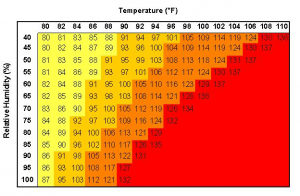Everyone who lives in Florida knows it gets very hot during the summer. Just as heat can affect humans it can affect cattle. Heat stress on cattle doesn’t just make them hot and uncomfortable, but it can also cost cattle producers millions of dollars each year.
Heat stress is caused by high ambient temperatures and high humidity. Cattle may begin feeling heat stress as the temperatures rise above 75° F. The optimal temperature for cattle is between 50° and 75° F. This comfort zone will vary for cattle depending on their body condition, hair length, level of nutrition, health, breed, color of hide, age and acclimation to their environment. As heat stress increases, so does water consumption. With the increase in water consumption there is an increase in urination which depletes the body of minerals such as salt, potassium, and magnesium, just as in humans.
There are different levels of heat stress on cattle. These levels are based on the heat index. The heat index is calculated by the ambient air temperature and the relative humidity percentage. A dangerous level is indicated by an index value of 79 or greater. On July 11, 2016 the temperature was 94° F with a relative humidity of 79% with a heat index of 129. This would be considered a dangerous level, as are most summer days in Florida, and precautions should be taken.
Cattle begin to feel heat stress long before we do. Some signs of stress include crowding under shade or trees or in ponds or around water troughs. Cattle may also begin to salivate more and exhibit open-mouthed or rapid breathing. Traditionally stress levels can be determined by the breathing levels. As cattle begin to feel the heat stress you may notice a decrease in their appetite. The further their appetite decreases the more they must utilize their stored energy. This can lead to a decrease in body condition or weight gain and also milk production. Heat stress has also been shown to decrease breeding efficiency. In extremely severe cases heat stress can cause death.
There are ways to reduce heat stress on cattle. Since we don’t feel the heat the way cattle do, planning for ways to reduce stress must begin early. One way to reduce heat stress is to provide enough shade for the number of cattle on the pasture and provide plenty of water. For cattle in barns, fans and sprinklers can assist in reducing the temperature and increasing the air flow. Rotating or working cattle in the early morning or late evening will reduce the amount of stress they encounter. You should provide free-choice minerals and salt so cattle can replenish the amount lost and meet their needs. Feeding cattle in the early morning or late evening will increase their feed consumption, reducing the amount of weight that is lost. Flies and other external parasites should be controlled. When there are excessive flies and parasites around cattle they tend to bunch up, increasing temperatures.
Some cattle are at a higher risk for having increased problems with heat stress. These cattle are those that were recently stressed from transporting or processing, sick cattle, dark hided cattle, heavily bred, older and reduced body condition score or thin cattle. We will never be able to make all cattle 100% comfortable. But it is important to take the necessary precautions to reduce as much stress on the cattle as possible. The more the cattle are under stress the more profits are lost.
For more information please contact your county extension agent.
____________
Sources:
Heat Stress and Beef Cattle, Stephen Boyles, OSU Beef Specialist
Reduce Heat Stress in Cattle to Maintain Profits, Stephen B. Blezinger, Ph. D.
Managing Heat Stress in Cattle, Dr. David Smith, Professor and Extension Veterinarian,
Veterinary and Biomedical Sciences, University of Nebraska – Lincoln
 0
0
